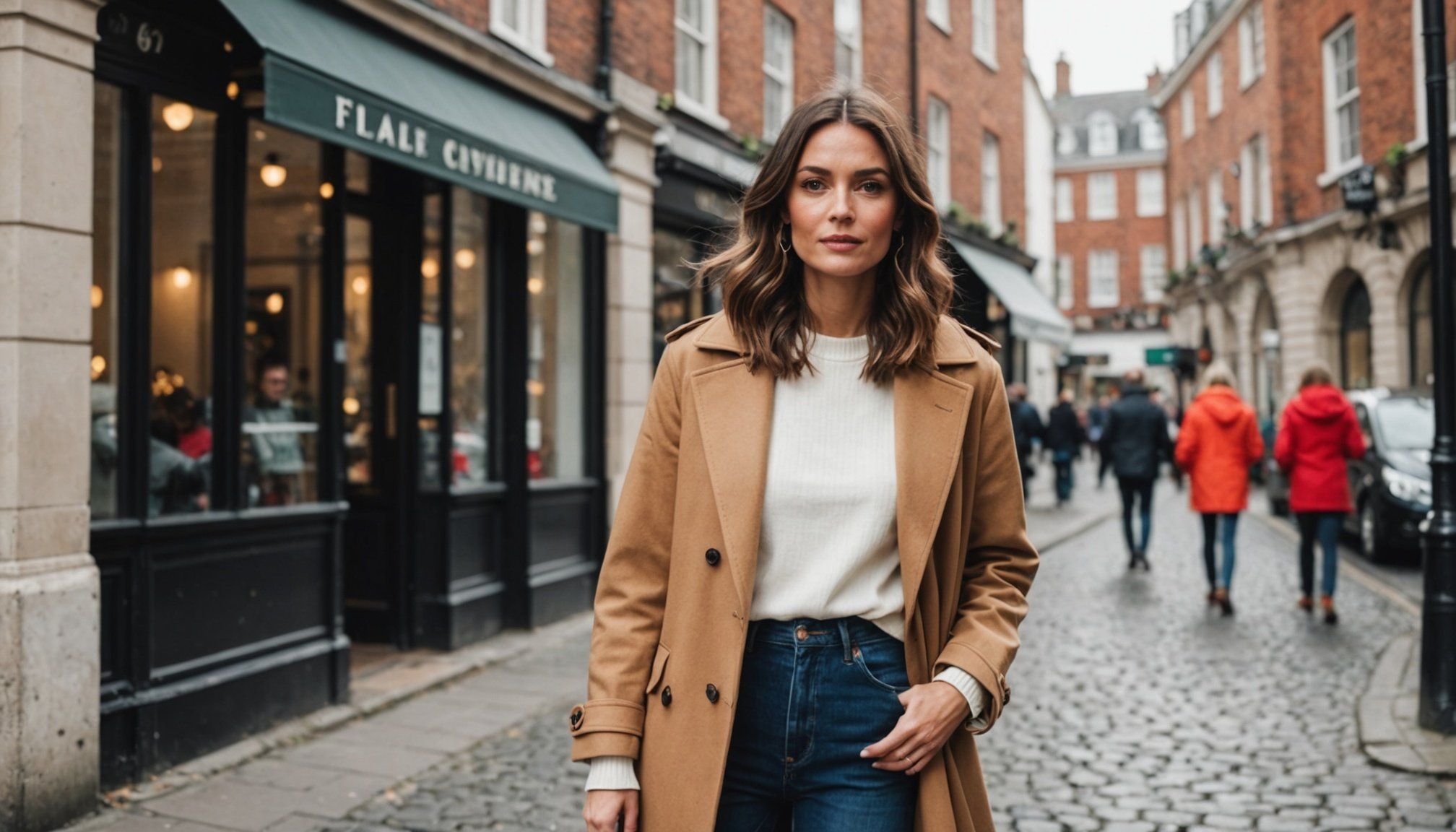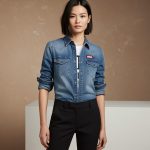Mastering the Art of Chic Layering: Fashion Tips for UK’s Ever-Changing Weather
Understanding the Importance of Layering
Layering is more than just a fashion trend; it’s a necessity in the UK, where the weather can be as unpredictable as it is varied. Whether you’re stepping out into a crisp autumn morning or braving a sudden downpour, layering allows you to adapt your outfit seamlessly without compromising on style.
“The beauty of autumn dressing is in its ability to incorporate a mix of items like lightweight jackets, knitwear, and shirts into one cohesive look,” notes an expert from Carl Thompson’s blog on men’s fashion[1].
This might interest you : Elevate your wardrobe with diesel shirts for women
The Golden Rule of Layering
To master the art of layering, you need to follow a simple yet effective rule: start with the thinnest fabrics closest to the skin and work your way out to the heavier materials. Here’s a step-by-step guide to layering:
- Base Layer: Begin with a fitted cotton T-shirt or long-sleeved shirt. This layer should be breathable and comfortable against your skin.
- Mid-Layer: Add a mid-weight jumper or cardigan. Crewneck jumpers, roll-necks (turtlenecks), and cardigans are excellent choices for this layer. They provide warmth without being too bulky[1].
- Outer Layer: Top it off with a coat or jacket. This could be anything from a classic trench coat to a more casual denim or bomber jacket.
Essential Pieces for Layering
Knitwear
Knitwear is a cornerstone of autumn and winter fashion in the UK. Here are some must-have knitwear pieces:
In parallel : Mastering Casual Elegance: Stylish Ways to Wear British Tweed for Everyday Adventures
- Crewneck Jumpers: Perfect for layering over a shirt or under a jacket, crewneck jumpers are versatile and can be dressed up or down.
- Roll-Necks (Turtlenecks): A timeless classic that adds a sophisticated edge to any outfit, ideal for wearing under blazers or coats.
- Cardigans: Shawl-collar cardigans have made a comeback and can be layered over shirts or lightweight jumpers for a smart yet casual look[1].
Outerwear
Outerwear is crucial for braving the UK’s unpredictable weather. Here are some key pieces:
- Trench Coats: A classic choice that never goes out of style. It’s perfect for both formal and casual occasions.
- Denim Jackets: A versatile and stylish option that can be paired with almost anything from jeans and a tee to sundresses and espadrilles[4].
- Bomber Jackets: Great for adding a sporty touch to your outfit while keeping you warm.
- Quilted Jackets: Ideal for transitional weather, quilted jackets can be styled with wide-leg trousers and sneakers for a casual-chic look[5].
Mixing Textures and Colors
Layering isn’t just about piling on garments; it’s about creating depth and dimension through different textures and colors.
Textures
Mixing different textures adds visual interest to your outfit. Here are some tips:
- Combine Smooth and Rough Textures: Pair smooth fabrics like cotton or silk with rougher textures like wool or denim.
- Add a Pop of Softness: Incorporate plush fabrics like fleece or cashmere to add warmth and comfort[2].
Colors
Choosing the right color combinations can elevate your look significantly. Here are some trending color combinations for the season:
- Burgundy + Black: A classic and stylish combination that makes any outfit look luxe. Pair a burgundy sweater with black trousers and accessories for a sophisticated look[3].
- Red + Grey: Introduce red into your wardrobe by pairing it with softening grey tones. This combination works well for both casual and formal outfits[3].
- Black + Navy: Contrary to popular advice, black and navy can be paired together beautifully. Use black accessories to offset navy pieces for a cohesive look[3].
Accessories: The Finishing Touches
Accessories can make or break an outfit. Here are some essential accessories to consider:
- Scarves: A scarf can add both warmth and personality to your outfit. Choose materials like wool, cashmere, or silk for the best results.
- Hats and Gloves: These are not just functional but also stylish. Look for high-quality materials that match your outfit’s color palette[2].
- Boots: Ankle boots, knee-high boots, and even snow boots can be great additions to your winter wardrobe. They add a stylish touch while keeping your feet warm[2].
Seasonal Layering Tips
Autumn Layering
Autumn is a time of transition, and your wardrobe should reflect this. Here are some tips for layering in autumn:
- Layer Lightweight Jackets: Use lightweight jackets like denim or bomber jackets over knitwear and shirts.
- Incorporate Warm Fabrics: Invest in wool, cashmere, or merino blends for your knitwear and outerwear. These fabrics offer both warmth and breathability[1].
Winter Layering
Winter layering is all about staying warm and stylish. Here are some tips:
- Hidden Layers: Use thermals and hidden layers to keep warm without bulking up your outfit.
- Quilted Gilets and Liner Jackets: These are winter hero items that can be layered over cosy knits or other jackets for added warmth[2].
Summer Layering
Yes, you read that right – layering is not just for cold weather. Here are some tips for layering in summer:
- Lightweight Cardigans: Use lightweight cardigans to add warmth in the evenings or on breezy days.
- Long-Sleeved Tops: Layer long-sleeved tops over light vests or sleeveless tops for a stylish and comfortable look[4].
Building a Capsule Wardrobe
A capsule wardrobe is essential for mastering the art of layering. Here’s how you can build one:
- Invest in High-Quality Pieces: Focus on buying a few high-quality, versatile pieces rather than a lot of cheap, trendy items.
- Mix and Match: Ensure that each piece can be mixed and matched with other items in your wardrobe to create multiple outfits[5].
Practical Insights and Actionable Advice
Creating a Stylish and Versatile Outfit
Here’s an example of how you can create a stylish and versatile outfit using layering:
- Base Layer: Start with a fitted cotton T-shirt or long-sleeved shirt.
- Mid-Layer: Add a crewneck jumper or cardigan.
- Outer Layer: Top it off with a denim jacket or a trench coat.
- Accessories: Add a scarf, hat, and gloves to complete the look.
Layering for Day and Night
Layering isn’t just for daytime; it can also be adapted for evening wear. Here’s how:
- Daytime: Layer a lightweight jacket over a knit sweater and trousers for a casual yet stylish look.
- Nighttime: Swap the lightweight jacket for a more formal coat or blazer to elevate your outfit[1].
Mastering the art of layering is about more than just throwing on a few clothes; it’s about creating a cohesive, stylish look that adapts to the ever-changing UK weather. By understanding the golden rule of layering, investing in essential pieces, mixing textures and colors, and accessorizing wisely, you can ensure that your wardrobe is both practical and fashionable.
As you embark on this journey of mastering the art of layering, remember that personal style is key. Don’t be afraid to experiment and find what works best for you. With the right pieces and a bit of creativity, you can create outfits that are stylish, comfortable, and perfect for any occasion.
Detailed Bullet Point List: Essential Pieces for Layering
- Base Layers
- Fitted cotton T-shirts
- Long-sleeved shirts
- Thermals (for winter)
- Mid-Layers
- Crewneck jumpers
- Roll-necks (turtlenecks)
- Cardigans
- Lightweight sweaters
- Outer Layers
- Trench coats
- Denim jackets
- Bomber jackets
- Quilted jackets
- Leather jackets (for summer and winter)
- Accessories
- Scarves (wool, cashmere, silk)
- Hats and gloves (for winter)
- Boots (ankle boots, knee-high boots, snow boots)
- Belts (to define the waist)
- Bags (totes, backpacks, cross-body bags)
Comprehensive Table: Seasonal Layering Tips
| Season | Base Layer | Mid-Layer | Outer Layer | Accessories |
|---|---|---|---|---|
| Autumn | Fitted cotton T-shirt or long-sleeved shirt | Crewneck jumper or cardigan | Lightweight jacket (denim or bomber) | Scarf, hat, gloves |
| Winter | Thermal or long-sleeved shirt | Knit sweater or cardigan | Trench coat or quilted jacket | Scarf, hat, gloves, boots |
| Summer | Tank top or sleeveless shirt | Lightweight sweater or cardigan | Lightweight jacket (denim or cotton) | Scarf, hat, sunglasses |
Relevant Quotes
- “The beauty of autumn dressing is in its ability to incorporate a mix of items like lightweight jackets, knitwear, and shirts into one cohesive look.”[1]
- “Mastering the art of layering is key. Start by selecting a base layer which can be a simple round neck T-shirt. Then, indulge in the plush comfort of fleece and knit favourites for added insulation.”[2]
- “Nothing screams ‘quiet luxury’ like wearing white in winter. Styling it with a rich brown instead of black creates a really soft, indulgent look.”[3]
Understanding the Basics of Chic Layering
Layering is not just a trend; it’s a style essential, especially in the UK weather where conditions change rapidly. Chic layering allows fashion enthusiasts to not only keep up with the latest trends but also ensures practicality in their attire selection.
Layering enhances both style and functionality by enabling wearers to adjust their outfits easily. When the chill of the morning is replaced by midday warmth, layers can be added or removed, maintaining comfort without compromising on aesthetic appeal. This adaptability is crucial for anyone navigating the UK’s ever-changing climate.
To master layering basics, consider the following key principles:
- Start with a base layer that wicks moisture, keeping you dry and comfortable.
- Follow with a middle layer that insulates, capturing warmth efficiently.
- Finish with a top layer that offers protection from wind or rain.
These layers must harmonize in terms of colour, texture, and fit to achieve a chic look. Such strategic layering not only aligns with the unpredictable weather but also adds dimension and interest to personal style. Embracing the art of layering elevates one’s fashion game, ensuring one is ready for any climatic surprise the day might offer.
Recommended Clothing Materials for Layering
When choosing clothing for layering, understanding the qualities of layering materials is crucial. Breathable fabrics are ideal for maintaining comfort, especially in varying climates. They allow moisture to escape, keeping you dry and comfortable. Popular breathable options include cotton and merino wool, which are excellent for regulating body temperature.
For the UK’s ever-changing weather, selecting season-appropriate fabrics becomes essential. In winter, fabrics like fleece and thermal wool provide insulation. These textiles trap warmth, offering a cozy barrier against cold weather. During milder conditions, such as spring or autumn, consider lighter options like linen or bamboo, which adapt well to fluctuating temperatures.
Texture also plays a critical role in layering effectively. Softer textures, like cashmere or silk, should be closer to your skin to prevent irritation. For outer layers, materials with a tougher texture, such as denim or leather, are advisable; these protect against external elements while still allowing the layers underneath to breathe.
Layering effectively not only ensures warmth but also elevates your style, making every layer functional and chic. Choosing the right materials can make a significant difference in comfort and performance, regardless of the season.
Stylish Layering Techniques
Layering is an art that, when mastered, can transform any outfit. Various layering techniques cater to different body types, ensuring everyone can embrace fashion layering with confidence.
For curvy figures, opt for longline jackets or cardigans that elongate the torso. Slim-fit layers can accentuate the waist, creating a balanced silhouette. On the contrary, for a more petite frame, avoid bulky styles that might overwhelm; instead, choose lighter fabrics and shorter hemlines that complement your proportions.
Accessories play a pivotal role in enhancing your layering methods. Scarves, belts, and hats aren’t merely add-ons; they contribute depth and texture to your ensemble. A statement belt can cinch the waist, while a structured hat can elevate any layered look.
Achieving a balanced silhouette is crucial in fashion layering. Proportion is key: pair a voluminous top with slim-fit bottoms or vice versa. This contrast ensures your outfit doesn’t appear too bulky or too thin. When in doubt, always layer from lightest to heaviest fabric to maintain a harmonious aesthetic.
By understanding your body, choosing the right accessories, and mastering proportions, anyone can innovate with their layering methods and revolutionise their personal style.
Outfit Examples for Various Occasions
Finding the perfect outfit for any occasion often requires some creativity and a well-curated wardrobe. Below are some ideas to inspire your fashion choices.
Smart Casual Looks
Smart casual is an essential style for many, offering a balance between comfort and sophistication. Achieving a casual chic appearance involves selecting versatile pieces that can easily transition from day to night. Consider combining a crisp button-down shirt with dark denim and adding a tailored blazer to elevate the ensemble. Shoes like loafers or brogues further accentuate this polished, yet relaxed look.
Outdoor Activities
For those embracing the outdoors, it’s important to maintain style while ensuring practicality. Layered outfits are ideal. Start with a moisture-wicking base layer, add a fleece for warmth, and top it off with a lightweight, weather-resistant jacket. Choose breathable fabrics to stay comfortable and pair the outfit with functional footwear. Accessories such as a beanie or scarf can add a stylish touch while keeping you warm.
Office-Ready Layers
Office attire need not be dull. Experimenting with layers can lead to a professional yet stylish look. Select a classic shirt as the base and add a slim-fit cardigan or a knitted vest for warmth and style. Complete the look with tailored trousers or a pencil skirt. Opt for occasion wear, like structured blazers, to add sophistication to the workplace ensemble.
Seasonal Trends in Layering
The art of seasonal layering is essential for navigating the ever-changing world of fashion. In autumn, layering trends lean towards plush textures and earthy tones, perfect for chilly mornings and warmer afternoons. Oversized knitted sweaters paired with sleek turtlenecks capture the essence of autumn fashion, providing both comfort and style. Scarves featuring bold patterns add personality while serving a practical purpose.
As winter approaches, layering becomes indispensable. Current winter layering trends showcase a shift towards luxurious materials such as cashmere and wool, often paired with tailored coats. Opt for layers that allow for ease of movement without compromising warmth, like lightweight down jackets layered under heavy outerwear.
Looking ahead, the spring and summer layering trends promise a return to lighter fabrics. Expect to see sheer cardigans and cropped jackets, which allow airflow while adding a flair of sophistication. Transitioning through seasons smoothly involves adapting your wardrobe by incorporating versatile pieces that work in varying temperatures.
A quick turnaround between frigid winter mornings and the blossoming warmth of spring means versatility is key. Layering styles with removable elements, such as detachable linings or convertible sleeves, offer a seamless adaptation between the sartorial needs of different seasons.
Color Coordination and Layering
Understanding the basics of color theory is crucial for effective color coordination and layering in fashion. At its core, color theory involves recognizing the relationships between colors on the color wheel. Complementary colors, such as blue and orange, can create a vibrant look when layered. However, analogous colors, which sit next to each other on the color wheel, like green and yellow, offer a more harmonious feel.
When layering colors, techniques like selecting a neutral base can serve as a foundation. This allows bolder colors to be layered on top, adding depth without overwhelming the look. Consider starting with a white or beige shirt, then adding a bright scarf or jacket.
To express personal style while layering, one can experiment with different fashion color tips. Choose colors that resonate with individual personality traits or moods. For instance, a warm ochre can convey friendliness, while a stark white might suggest sophistication. Balancing bold and soft shades creates synergy in any outfit, making it both eye-catching and unique.
Incorporating these concepts helps refine personal style while exploring the versatility that color coordination and layering offer.
Practical Tips for Maintaining Style and Comfort
Achieving both style and comfort is simpler than you might think. Layering is a fantastic way to access a versatile look while maintaining ease of movement. Here’s some stylish layering advice to help you adapt throughout the day.
Start with a breathable, comfortable base layer that fits snugly to your body, serving as the foundation. This is crucial for maintaining warmth without compromising on style. The next layer should add a touch of fashion without restricting movement. Think of easy-to-wear pieces, such as cardigans or lightweight jackets, which can be removed or added as needed.
In the spirit of fashion comfort tips, always consider the day’s activities and adjust your layers accordingly. For example, indoor settings may require you to reduce layers, while outdoors, you might want to add warmth.
Practical tips for ensuring all-day wearability include selecting fabrics that breathe well and move with your body, avoiding stiffness. Opt for materials like cotton or wool blend, which not only provide comfort but also elegance.
By mastering the art of layering, you’ll stay both stylish and comfortable as you go about your day.











